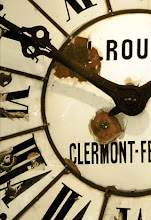Before setting up this website of Vintage Clocks Roger Lascelles used to supply John Lewis with classic reproduction clocks some based on styles from the old clocks shown on this website.
Below is a photograph and article which appeared in John Lewis's internal magazine.

“I make clocks that people can take a real pleasure in owning. They are colourful, distinctive and a world away from the plain, rather boring, clocks from most companies. They all have a strong link to the past with the designs inspired by an old clock, or part of one, that I have found in an antique market in France or Britain, but they also reflect today’s trends. I was in Paris last weekend and have come back with a glass face and a pretty tin nursery plate with a painted clock face. I’ve no idea what I will do with them but for now they’re on my work table with other bits and pieces until they filter into the design process.
I can’t say I started life with a passion for clocks – it’s something that has just happened. Now the workshop is full of wonderful old clocks, from stations, cafés, homes. The remains of huge 17th-century French clocks that once sat in a château or 1950s gems in Bakelite surround us. They all have a story to tell and a bit of that ends up in the design.
My route to being a clock designer hasn’t been the most straightforward. I went to university in Hawaii where I studied travel and tourism and I was Director of Tourism in the Seychelles in the 1970s. I came back to the UK at the beginning of 1974 in the middle of an economic downturn. I had an MBA, but in the UK people either didn’t know what it was or it made me overqualified. I had to find a different way to earn a living so I started to buy antiques and bric-a-brac and sell it from a friend’s shop. And that’s how I got into clocks. I loved the faces on old grandfather clocks and started to photograph them. I made a poster with photographs of 10 different grandfather clocks but it was a disaster and nobody bought it. Instead we cut out the individual faces from the poster and used them to make our first clocks. That was the start of this business.
We now make 100,000 clocks a year. We were only selling a few in our Fulham shop but someone had tipped off the clock buyer at John Lewis [R M Jacob] and he got on the bus and came down to see us. He placed an order for £5,000. That was in 1985 and John Lewis was my first retail customer. Now, all these years later, it is still my biggest customer. We had found a little niche by accident and we have gone on developing our own distinctive look.
We design all our clocks here in our Wandsworth workshop, trying to use a bit of the past but with a modern edge. We often take an element from one clock – perhaps the hands – and combine it with, say, the numerals from another clock face. It is amazing when you look at the numbers how distinctive and individual they can be. It can take six months to develop an idea, tweaking it here and there – changing the colour, shape, dimension. They are all fitted with a quartz mechanism that we buy in. We do get copied by other manufacturers but we have to live with that. After all, it’s very flattering and we have the talent to constantly come up with new designs.”
Interview: Jacqueline Mair
March 08




 “I make clocks that people can take a real pleasure in owning. They are colourful, distinctive and a world away from the plain, rather boring, clocks from most companies. They all have a strong link to the past with the designs inspired by an old clock, or part of one, that I have found in an antique market in France or Britain, but they also reflect today’s trends. I was in Paris last weekend and have come back with a glass face and a pretty tin nursery plate with a painted clock face. I’ve no idea what I will do with them but for now they’re on my work table with other bits and pieces until they filter into the design process.
“I make clocks that people can take a real pleasure in owning. They are colourful, distinctive and a world away from the plain, rather boring, clocks from most companies. They all have a strong link to the past with the designs inspired by an old clock, or part of one, that I have found in an antique market in France or Britain, but they also reflect today’s trends. I was in Paris last weekend and have come back with a glass face and a pretty tin nursery plate with a painted clock face. I’ve no idea what I will do with them but for now they’re on my work table with other bits and pieces until they filter into the design process.



 LARGE CIRCULAR PEDESTAL TABLE
LARGE CIRCULAR PEDESTAL TABLE

